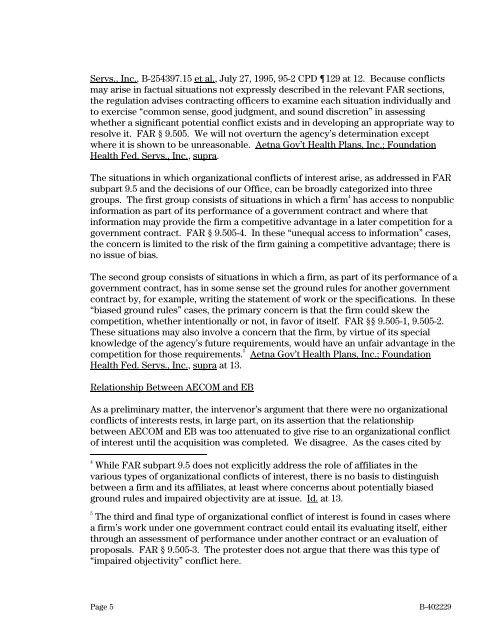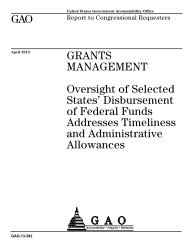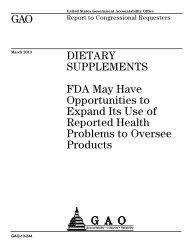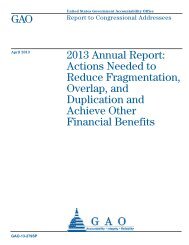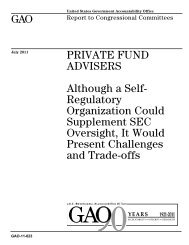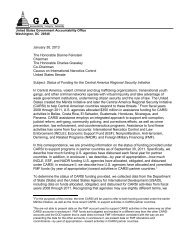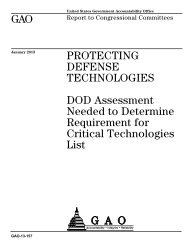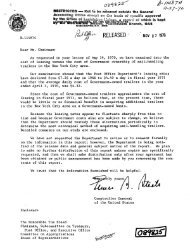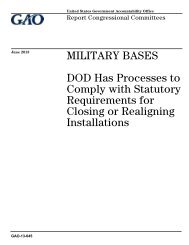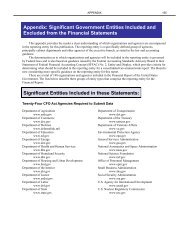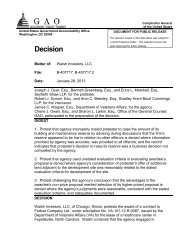B-402229 B.L. Harbert-Brasfield & Gorrie, JV - US Government ...
B-402229 B.L. Harbert-Brasfield & Gorrie, JV - US Government ...
B-402229 B.L. Harbert-Brasfield & Gorrie, JV - US Government ...
Create successful ePaper yourself
Turn your PDF publications into a flip-book with our unique Google optimized e-Paper software.
Servs., Inc., B-254397.15 et al., July 27, 1995, 95-2 CPD 129 at 12. Because conflicts<br />
may arise in factual situations not expressly described in the relevant FAR sections,<br />
the regulation advises contracting officers to examine each situation individually and<br />
to exercise “common sense, good judgment, and sound discretion” in assessing<br />
whether a significant potential conflict exists and in developing an appropriate way to<br />
resolve it. FAR § 9.505. We will not overturn the agency’s determination except<br />
where it is shown to be unreasonable. Aetna Gov’t Health Plans, Inc.; Foundation<br />
Health Fed. Servs., Inc., supra.<br />
The situations in which organizational conflicts of interest arise, as addressed in FAR<br />
subpart 9.5 and the decisions of our Office, can be broadly categorized into three<br />
groups. The first group consists of situations in which a firm 4 has access to nonpublic<br />
information as part of its performance of a government contract and where that<br />
information may provide the firm a competitive advantage in a later competition for a<br />
government contract. FAR § 9.505-4. In these “unequal access to information” cases,<br />
the concern is limited to the risk of the firm gaining a competitive advantage; there is<br />
no issue of bias.<br />
The second group consists of situations in which a firm, as part of its performance of a<br />
government contract, has in some sense set the ground rules for another government<br />
contract by, for example, writing the statement of work or the specifications. In these<br />
“biased ground rules” cases, the primary concern is that the firm could skew the<br />
competition, whether intentionally or not, in favor of itself. FAR §§ 9.505-1, 9.505-2.<br />
These situations may also involve a concern that the firm, by virtue of its special<br />
knowledge of the agency’s future requirements, would have an unfair advantage in the<br />
competition for those requirements. 5<br />
Aetna Gov’t Health Plans, Inc.; Foundation<br />
Health Fed. Servs., Inc., supra at 13.<br />
Relationship Between AECOM and EB<br />
As a preliminary matter, the intervenor’s argument that there were no organizational<br />
conflicts of interests rests, in large part, on its assertion that the relationship<br />
between AECOM and EB was too attenuated to give rise to an organizational conflict<br />
of interest until the acquisition was completed. We disagree. As the cases cited by<br />
4<br />
While FAR subpart 9.5 does not explicitly address the role of affiliates in the<br />
various types of organizational conflicts of interest, there is no basis to distinguish<br />
between a firm and its affiliates, at least where concerns about potentially biased<br />
ground rules and impaired objectivity are at issue. Id. at 13.<br />
5<br />
The third and final type of organizational conflict of interest is found in cases where<br />
a firm’s work under one government contract could entail its evaluating itself, either<br />
through an assessment of performance under another contract or an evaluation of<br />
proposals. FAR § 9.505-3. The protester does not argue that there was this type of<br />
“impaired objectivity” conflict here.<br />
Page 5 B-<strong>402229</strong>


